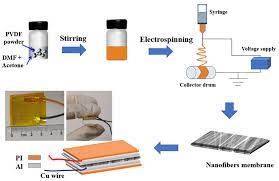Australian researchers have made a groundbreaking discovery in the field of electronic sensors by developing a molecular-sized, highly efficient version of the commonly used piezoresistor. This breakthrough has the potential to revolutionize various industries and bring about widespread benefits.
Piezoresistors are widely utilized for vibration detection in electronics and automobiles, such as in smartphones for step counting and in airbag deployment systems. They are also essential components in medical devices like implantable pressure sensors, as well as in aviation and space travel.
Led by Dr. Nadim Darwish from Curtin University, Professor Jeffrey Reimers from the University of Technology Sydney, Associate Professor Daniel Kosov from James Cook University, and Dr. Thomas Fallon from the University of Newcastle, a team of Australian researchers has successfully developed a piezoresistor that is approximately 500,000 times smaller than the width of a human hair.
The results of their research have been published in a reputed scientific journal, Nature Communications, under the title “Controlling Piezoresistance in Single Molecules through the Isomerisation of Bullvalenes.”
Dr. Darwish explained that they have created a more sensitive and miniaturized variant of this crucial electronic component that converts force or pressure into an electrical signal, which is widely used in everyday applications. The size and chemical composition of this new piezoresistor open up a whole new range of possibilities for chemical and biosensors, human-machine interfaces, and health monitoring devices, according to Dr. Darwish.
Due to their molecular nature, these new sensors can be employed to detect other chemicals or biomolecules like proteins and enzymes, representing a potential game-changer in disease detection.
Dr. Fallon revealed that the newly developed piezoresistor is made from a single molecule of bullvalene, which undergoes a reaction when mechanically strained, resulting in a new molecule with a different shape that alters the flow of electricity by changing resistance.
These different chemical forms, known as isomers, have been utilized for the first time in the development of piezoresistors. Dr. Fallon added that the team has successfully modeled the complex series of reactions that occur, providing a clear understanding of how single molecules can react and transform in real time.
Professor Reimers emphasized the significance of the ability to electrically detect the changes in the shape of a reacting molecule, back and forth, approximately once every millisecond. This concept of detecting molecular shapes through electrical conductance represents a major breakthrough in chemical sensing.
Associate Professor Kosov highlighted the importance of understanding the relationship between molecular shape and conductivity, as it enables the determination of fundamental properties of molecular junctions with attached metallic conductors. This newfound capability is crucial to the future advancement of all molecular electronic devices, according to Associate Professor Kosov.
Overall, the development of this miniaturized piezoresistor represents a significant leap forward in the field of electronic sensors. Its molecular composition and enhanced sensitivity offer unprecedented opportunities in various industries, including healthcare, electronics, and aerospace. With the ability to detect a wide range of chemicals and biomolecules, this breakthrough has the potential to greatly impact disease diagnosis and monitoring in the future.
*Note:
1.Source: Coherent Market Insights, Public sources, Desk research
2.We have leveraged AI tools to mine information and compile it




